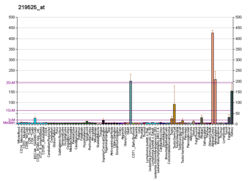Multidrug and toxin extrusion protein 1
Multidrug and toxin extrusion protein 1 (MATE1), also known as solute carrier family 47 member 1, is a protein that in humans is encoded by the SLC47A1 gene.[5][6] SLC47A1 belongs to the MATE (multidrug and toxic compound extrusion) family of transporters that are found in bacteria, archaea and eukaryotes.[7][8]
Gene
The SLC47A1 gene is located within the Smith–Magenis syndrome region on chromosome 17.[5]
Function
SLC47A1 is a member of the MATE family of transporters that excrete endogenous and exogenous toxic electrolytes through urine and bile.[6]
Discovery
The multidrug efflux transporter NorM from V. parahaemolyticus which mediates resistance to multiple antimicrobial agents (norfloxacin, kanamycin, ethidium bromide etc.) and its homologue from E. coli were identified in 1998, which is the first of Solute carrier family 47 member.[7] NorM seems to function as drug/sodium antiporter which is the first example of Na+-coupled multidrug efflux transporter.[9] NorM is a prototype of a new transporter family and Brown et al. named it the multidrug and toxic compound extrusion family.[8] The X-ray structure of the transporter NorM was determined to 3.65 Å, revealing an outward-facing conformation with two portals open to the outer leaflet of the membrane and a unique topology of the predicted 12 transmembrane helices distinct from any other known multidrug resistance transporter.[10]
See also
- MATE (Multi antimicrobial extrusion protein or multidrug and toxic compound extrusion protein)
References
- GRCh38: Ensembl release 89: ENSG00000142494 - Ensembl, May 2017
- GRCm38: Ensembl release 89: ENSMUSG00000010122 - Ensembl, May 2017
- "Human PubMed Reference:". National Center for Biotechnology Information, U.S. National Library of Medicine.
- "Mouse PubMed Reference:". National Center for Biotechnology Information, U.S. National Library of Medicine.
- "Entrez Gene: FLJ10847 hypothetical protein FLJ10847".
- Otsuka M, Matsumoto T, Morimoto R, Arioka S, Omote H, Moriyama Y (December 2005). "A human transporter protein that mediates the final excretion step for toxic organic cations". Proc. Natl. Acad. Sci. U.S.A. 102 (50): 17923–8. doi:10.1073/pnas.0506483102. PMC 1312386. PMID 16330770.
- Morita Y, Kodama K, Shiota S, Mine T, Kataoka A, Mizushima T, Tsuchiya T (July 1998). "NorM, a putative multidrug efflux protein, of Vibrio parahaemolyticus and its homolog in Escherichia coli". Antimicrob. Agents Chemother. 42 (7): 1778–82. doi:10.1128/AAC.42.7.1778. PMC 105682. PMID 9661020.
- Brown MH, Paulsen IT, Skurray RA (January 1999). "The multidrug efflux protein NorM is a prototype of a new family of transporters". Mol. Microbiol. 31 (1): 394–5. doi:10.1046/j.1365-2958.1999.01162.x. PMID 9987140.
- Morita Y, Kataoka A, Shiota S, Mizushima T, Tsuchiya T (December 2000). "NorM of vibrio parahaemolyticus is an Na(+)-driven multidrug efflux pump". J. Bacteriol. 182 (23): 6694–7. doi:10.1128/JB.182.23.6694-6697.2000. PMC 111412. PMID 11073914.
- He X, Szewczyk P, Karykin A, Hong WX, Zhang Q, Chang G (2010). "Structure of a cation-bound multidrug and toxic compound extrusion transporter". Nature. 467 (7318): 991–4. doi:10.1038/nature09408. PMC 3152480. PMID 20861838.
Further reading
- Maruyama K, Sugano S (1994). "Oligo-capping: a simple method to replace the cap structure of eukaryotic mRNAs with oligoribonucleotides". Gene. 138 (1–2): 171–4. doi:10.1016/0378-1119(94)90802-8. PMID 8125298.
- Suzuki Y, Yoshitomo-Nakagawa K, Maruyama K, et al. (1997). "Construction and characterization of a full length-enriched and a 5'-end-enriched cDNA library". Gene. 200 (1–2): 149–56. doi:10.1016/S0378-1119(97)00411-3. PMID 9373149.
- Bi W, Yan J, Stankiewicz P, et al. (2002). "Genes in a refined Smith-Magenis syndrome critical deletion interval on chromosome 17p11.2 and the syntenic region of the mouse". Genome Res. 12 (5): 713–28. doi:10.1101/gr.73702. PMC 186594. PMID 11997338.
- Strausberg RL, Feingold EA, Grouse LH, et al. (2003). "Generation and initial analysis of more than 15,000 full-length human and mouse cDNA sequences". Proc. Natl. Acad. Sci. U.S.A. 99 (26): 16899–903. doi:10.1073/pnas.242603899. PMC 139241. PMID 12477932.
- Ota T, Suzuki Y, Nishikawa T, et al. (2004). "Complete sequencing and characterization of 21,243 full-length human cDNAs". Nat. Genet. 36 (1): 40–5. doi:10.1038/ng1285. PMID 14702039.
- Otsuka M, Matsumoto T, Morimoto R, et al. (2006). "A human transporter protein that mediates the final excretion step for toxic organic cations". Proc. Natl. Acad. Sci. U.S.A. 102 (50): 17923–8. doi:10.1073/pnas.0506483102. PMC 1312386. PMID 16330770.
- Ohta KY, Inoue K, Hayashi Y, Yuasa H (2006). "Molecular identification and functional characterization of rat multidrug and toxin extrusion type transporter 1 as an organic cation/H+ antiporter in the kidney". Drug Metab. Dispos. 34 (11): 1868–74. doi:10.1124/dmd.106.010876. PMID 16928787.
- Omote H, Hiasa M, Matsumoto T, et al. (2007). "The MATE proteins as fundamental transporters of metabolic and xenobiotic organic cations". Trends Pharmacol. Sci. 27 (11): 587–93. doi:10.1016/j.tips.2006.09.001. PMID 16996621.
- Tsuda M, Terada T, Asaka J, et al. (2007). "Oppositely directed H+ gradient functions as a driving force of rat H+/organic cation antiporter MATE1". Am. J. Physiol. Renal Physiol. 292 (2): F593–8. doi:10.1152/ajprenal.00312.2006. PMID 17047166.
- Chen Y, Zhang S, Sorani M, Giacomini KM (2007). "Transport of paraquat by human organic cation transporters and multidrug and toxic compound extrusion family". J. Pharmacol. Exp. Ther. 322 (2): 695–700. doi:10.1124/jpet.107.123554. PMID 17495125.
- Tanihara Y, Masuda S, Sato T, et al. (2007). "Substrate specificity of MATE1 and MATE2-K, human multidrug and toxin extrusions/H(+)-organic cation antiporters". Biochem. Pharmacol. 74 (2): 359–71. doi:10.1016/j.bcp.2007.04.010. hdl:2433/124277. PMID 17509534.
- Kajiwara M, Terada T, Asaka J, et al. (2007). "Critical roles of Sp1 in gene expression of human and rat H+/organic cation antiporter MATE1". Am. J. Physiol. Renal Physiol. 293 (5): F1564–70. doi:10.1152/ajprenal.00322.2007. PMID 17855482.




